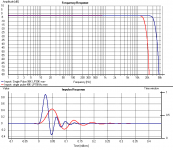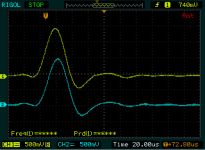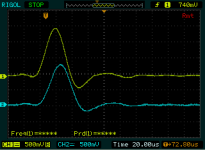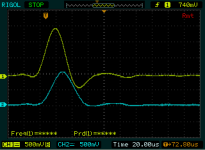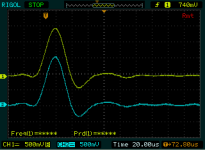I have heard differences between IC's with similar specifications. I have never been able to find an IC that sounds as good as a well designed discrete circuit, either.
Sorry John, but as someone who doesn't trust his ears enough to agree to a controlled test, that's just personal opinion, nothing more.
And for those who will have a knee-jerk reaction to fall all over me: please try to follow my reasoning. I agree that John is a great designer, I agree that John is a very successful designer. OK?
jan didden
Jan,
I use to make the difference between the 2 channels with both an analog or a digital scope: this difference signal can be displayed with a higher sensitivity scale. [snip].
What type of digital scope? All I know have 8 bit resolution.You still haven't answered my question of how big the difference can be before they start to sound different.
<snip>Levels: <snip>
I was asking about the level of the pulse you measure with.
jan didden
I hear differences between different IC's, yet their data sheet specifications are similar. You know; noise, slew rate, distortion, etc.
The datasheet has nothing to do with it. Someone proposed a test that made him happy, I was just commenting on one possible conclusion.
What type of digital scope? All I know have 8 bit resolution.You still haven't answered my question of how big the difference can be before they start to sound different.
Actually, I use an E-MU 0202 sound card, with 24 bit resolution.
About the differences, I can say that for the amp I showed the pulses some posts ago, an audible difference can be noted between each of the three curves showed. I didn't investigate what is the limit of the measure. It was not my goal. I'm sorry.
I was asking about the level of the pulse you measure with.
Sorry, Jan I have misread your question. The input level of the pulse usually is 0,5-1 Vpk for amps and 0,1 - 1 Vpk for line level pre-amps.
I had a look at the pulse that Luigi uses. He supplied it as a 96KHz, 16bit file. The pulse is indeed LP filtered at 24Khz and contains mostly equal energy down to 10Hz, where it rises quickly by about 16dB. This bass bump may help in the amp matching, I don't know.
EDIT: Once I trimmed the tail off the pulse, it loses its low end bump, so that may have been something picked up in capture.
EDIT: Once I trimmed the tail off the pulse, it loses its low end bump, so that may have been something picked up in capture.
So what we're actually talking about is *visually* comparing two band-limited pulses through plain ordinary electronics and drawing a useful conclusion. Sorry, ain't buyin' it.
If there's more to the story it hasn't dribbled out yet.
Chris
I also have my doubts. I mean, we have people claiming to hear differences between amps like 3 degrees of phase shift at 20kHz, or the difference between an amp with 0.1% THD and one with 0.01% THD. Or even claiming differences that cannot be measured with anything known to man. And now just eyeballing a couple of pulses will tell you what sounds the same and what not? Not saying it's impossible but I am extremely sceptic.
Also, how do you confirm it? Suppose your pulse says: these amps sound the same. How do you find out that is or is not the case? Did someone mention a couple of controlled tests?
There are a few studies on my personal websites of people trying to use impulse like signals to test amplifiers, one from a guy called Southworth from 1966 and then the famous Hirata from 1981. What they did was process the pulse response to try to extract significant data. But just eyeballing it....?
Edit: The papers are here (left column): http://www.linearaudio.nl/library misc.htm
jan didden
The interesting point is the infrasonic rise.
I believe that was just an artifact. When the file is cut to just the pulse + few samples after, the rise goes away. So does a lot of noise in the 50-60Hz range. They may have been noise captured with the signal. I don't know if that is important, or not.
Pulse files
For those of you who wish to do your own pulse testing, here are 2 files for you.
One is a 96Khz sample rate low passed at 30Khz, 4th order. It started life as a single sample ON, all others OFF until low pass filtering. It contains equal energy from at least 1Hz to the beginning of the 30Khz roll off. The pulse hits a peak level of -2.5dBFS to be kind to your DAC.
The second file is sampled at 48Khz for those who don't have 96KHz measurement rates. It also started life as a single sample ON. Then it was low passed to 15Khz (about the highest possible at 48K).
Both files have a series of single pulses. 1 pulse every 2 seconds. Have fun!
For those of you who wish to do your own pulse testing, here are 2 files for you.
One is a 96Khz sample rate low passed at 30Khz, 4th order. It started life as a single sample ON, all others OFF until low pass filtering. It contains equal energy from at least 1Hz to the beginning of the 30Khz roll off. The pulse hits a peak level of -2.5dBFS to be kind to your DAC.
The second file is sampled at 48Khz for those who don't have 96KHz measurement rates. It also started life as a single sample ON. Then it was low passed to 15Khz (about the highest possible at 48K).
Both files have a series of single pulses. 1 pulse every 2 seconds. Have fun!
Attachments
Jan,
M. Schroeder and R. Neve have both reported in print they could discern 5 degrees at 20 Khz.
If I get around to it I will send you some .wav files of small phase shift waveforms with the same amplitude.
ES
Ed I don't doubt that such things can be heard, by experienced people, under the right set of circumstances. My point is that if such small differences can lead to audible differences, how are we going to decide whether two amps sound the same or not just by looking at a couple of pulses on a scope?
jan didden
The same pulse.wav, captured with digital scope, without bandlimiting and with BW limit(-3B) with first order RC network (at input of preamp with BW over 1MHz) to 50,20,10kHz. Results are not nor surprising nor special..1.channel is input , 2.channel output from preamp. Last pictute w/o BW limit
Attachments
Last edited:
Hi,
I think with such claims we need to be careful.
For example, if I find an observable difference in sound quality between two amplifiers, one with (say) 0.01% THD and the other with 0.001% THD being the major difference that can be measured using traditional means, it is often tempting to attribute the audible difference to the measurable one, as these days there appears to be a requirement to explain simple observations, rather than to admit that actual cause is unknown.
At least some will outright reject any observation that is not explained. And in fact, they often those turn a given observation in their claims into something that "claims to not be measurable" and equally often attempt to dismiss any observations that do not fit their world-view as "hallucinations".
Just because something does not show up with traditionals measurements does not mean it does not exist, previous examples of these are blocking/sticking distortion (which is often signal history dependent and not observed with steady state signals), SID/TIM/PIM, Thermal Memory and others. There was a time when the existing of any of those was denied by those with orthodox tendencies refused to even acknowledge the observations they caused, as the then "best known" measurements fiald to show them.
Nowadays we CAN measure all of the ones we know about, even though most of the more esoteric (and possibly in terms of subjective sonic terms quite pernicious) distortions are rarely measured, nor do standardised methods exist.
Moreover, to claim that it is not possible that effects exists that current available instrumentation fails to capture is a sign, not of knowledge or experience, but of either prejudice/ignorance or of incredible intellectual arrogance...
No-one here would subscribe to such a view as outlined above, though reading some contributors posts often makes me doubt my convictions on that point.
On the other hand, I routinely "eyeball" impulse responses for signs that the amplifier deviates from my intentions and then fix the problems. So I think "eyeballing" impulse response is a valid method.
There are many ways to analyse a given device and to compare the results between two different ones. Non of these are invalid, they simply tell us different parts of the story.
Ciao T
I also have my doubts. I mean, we have people claiming to hear differences between amps like 3 degrees of phase shift at 20kHz, or the difference between an amp with 0.1% THD and one with 0.01% THD. Or even claiming differences that cannot be measured with anything known to man.
I think with such claims we need to be careful.
For example, if I find an observable difference in sound quality between two amplifiers, one with (say) 0.01% THD and the other with 0.001% THD being the major difference that can be measured using traditional means, it is often tempting to attribute the audible difference to the measurable one, as these days there appears to be a requirement to explain simple observations, rather than to admit that actual cause is unknown.
At least some will outright reject any observation that is not explained. And in fact, they often those turn a given observation in their claims into something that "claims to not be measurable" and equally often attempt to dismiss any observations that do not fit their world-view as "hallucinations".
Just because something does not show up with traditionals measurements does not mean it does not exist, previous examples of these are blocking/sticking distortion (which is often signal history dependent and not observed with steady state signals), SID/TIM/PIM, Thermal Memory and others. There was a time when the existing of any of those was denied by those with orthodox tendencies refused to even acknowledge the observations they caused, as the then "best known" measurements fiald to show them.
Nowadays we CAN measure all of the ones we know about, even though most of the more esoteric (and possibly in terms of subjective sonic terms quite pernicious) distortions are rarely measured, nor do standardised methods exist.
Moreover, to claim that it is not possible that effects exists that current available instrumentation fails to capture is a sign, not of knowledge or experience, but of either prejudice/ignorance or of incredible intellectual arrogance...
No-one here would subscribe to such a view as outlined above, though reading some contributors posts often makes me doubt my convictions on that point.
What they did was process the pulse response to try to extract significant data. But just eyeballing it....?
On the other hand, I routinely "eyeball" impulse responses for signs that the amplifier deviates from my intentions and then fix the problems. So I think "eyeballing" impulse response is a valid method.
There are many ways to analyse a given device and to compare the results between two different ones. Non of these are invalid, they simply tell us different parts of the story.
Ciao T
There are many ways to analyse a given device and to compare the results between two different ones. Non of these are invalid, they simply tell us different parts of the story.
This is absolutely correct, THD is the main criterion at the championship between amps, which is judged by entities with scopes instead of heads.
Its a pitty, that scopes rarely (almost accidentally) agree with listeners and musicians.
What we all seeking for, is what pulses, formula, or spectra would lead to agreement with listeners. Its really a challenge.
Somebody tend to create or to prove their "know-everything-status", since it is probably needed for their professional situation.
DIYers do not depend on the estimates of their status, and are more inclined to new ways of thinking.
Last edited:
Hi,
I think with such claims we need to be careful.
For example, if I find an observable difference in sound quality between two amplifiers, one with (say) 0.01% THD and the other with 0.001% THD being the major difference that can be measured using traditional means, it is often tempting to attribute the audible difference to the measurable one, as these days there appears to be a requirement to explain simple observations, rather than to admit that actual cause is unknown.[snip]
Which was not the point made of course.
[snip]On the other hand, I routinely "eyeball" impulse responses for signs that the amplifier deviates from my intentions and then fix the problems. So I think "eyeballing" impulse response is a valid method.
[snip]Ciao T
Which was not the point either.
But thanks for taking the time to react
jan didden
And what about to try known Baxandall diferential test, compare in real time input vs. output of an amplifier with real music signal and hear resulting artefacts in isolation and then try to capture them in musical signal (from which they originated) in correct amplitude proportion. This can be big surprise for many they believe "they can hear".
And what about to try known Baxandall diferential test, compare in real time input vs. output of an amplifier with real music signal and hear resulting artefacts in isolation and then try to capture them in musical signal (from which they originated) in correct amplitude proportion. This can be big surprise for many they believe "they can hear".
Do not overestimate possibilities of standard measuring instruments. For prooving listenable artefacts by measurements, we usually need super-low-noise, super screened measurements, like done for istance by Ed Simon and some others.
In spite that I have 192kHz 24bit Juli sound card, I never tried to catch listenable artefacts by using it, simply do not believe that it is possible. I consider the pulse test discussed here as a mean of rough estimate, more informative than THD, but proper designed amps usually differ in tiny details, like different listening impressions after changing series reg PS by shunt reg. And measured equivalent of different listening impressions, as per my beliefe, is hidden under the noise floor. With standard instruments, we for sure can measure things, that correlate with impressions from bass reproduction, and serial or shunt PS have minor influence on bass impressions, if their Zout similar. But this is a low league, effects of sound transparancy and "live-event-impressions" belong to the high league, where high-end components are playing.
Last edited:
The problem with this scenario is that unmeasurable, tiny audible differences haven't been shown to exists once you use only your ears in comparing amps. And IF you can hear a difference, it is generally easy to find a measurable difference, like the 5 degrees in phase shif difference at 20kHz Ed mentioned, or a difference in THD of 0.1% versus 0.01%.
Also with power supplies; if they cause audible differences, you can measure that.
After all, if you have an audible difference it MUST be the result from an electrical difference at the speaker plugs.
jan didden
Also with power supplies; if they cause audible differences, you can measure that.
After all, if you have an audible difference it MUST be the result from an electrical difference at the speaker plugs.
jan didden
- Status
- Not open for further replies.
- Home
- Member Areas
- The Lounge
- John Curl's Blowtorch preamplifier part II
